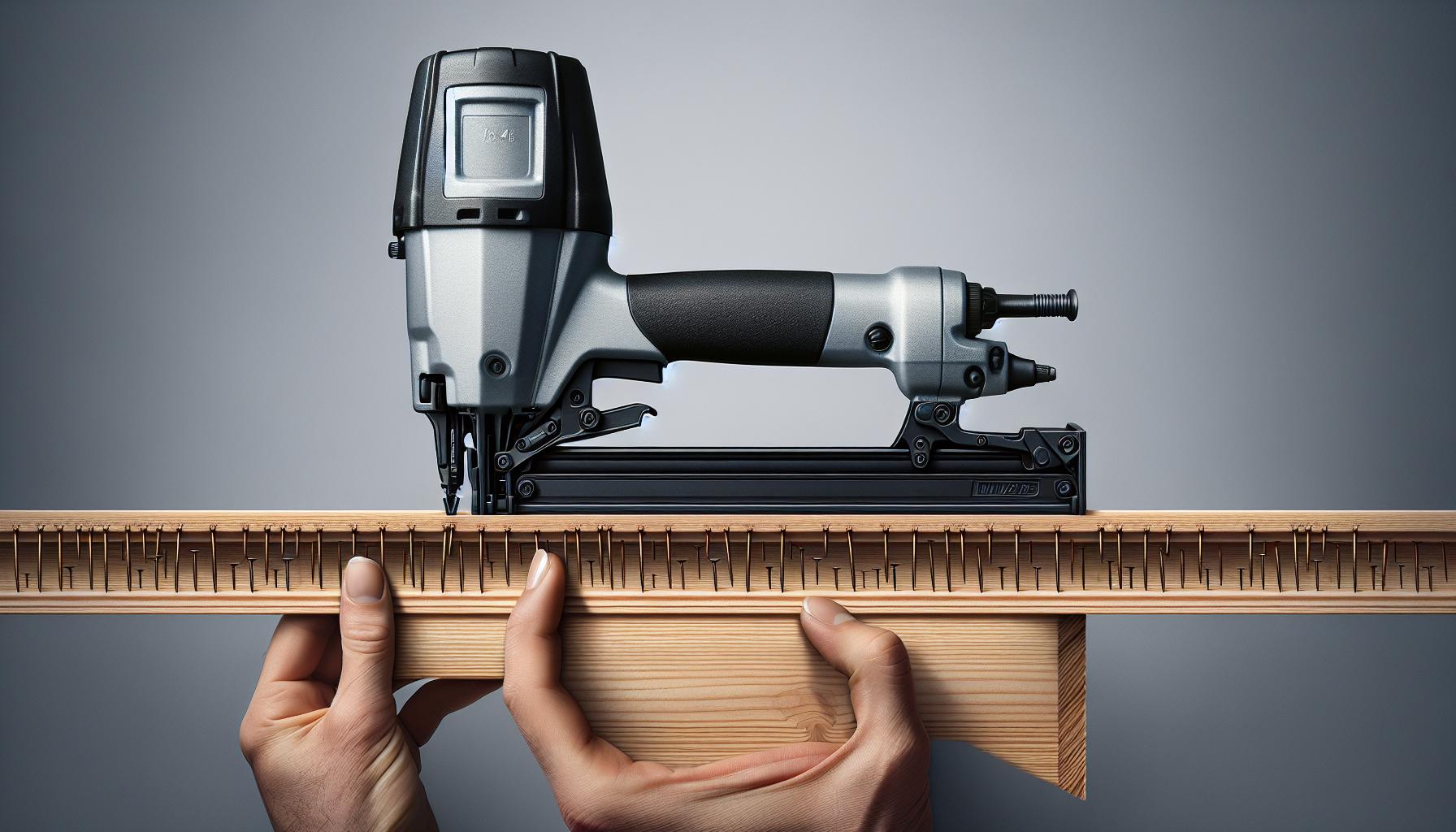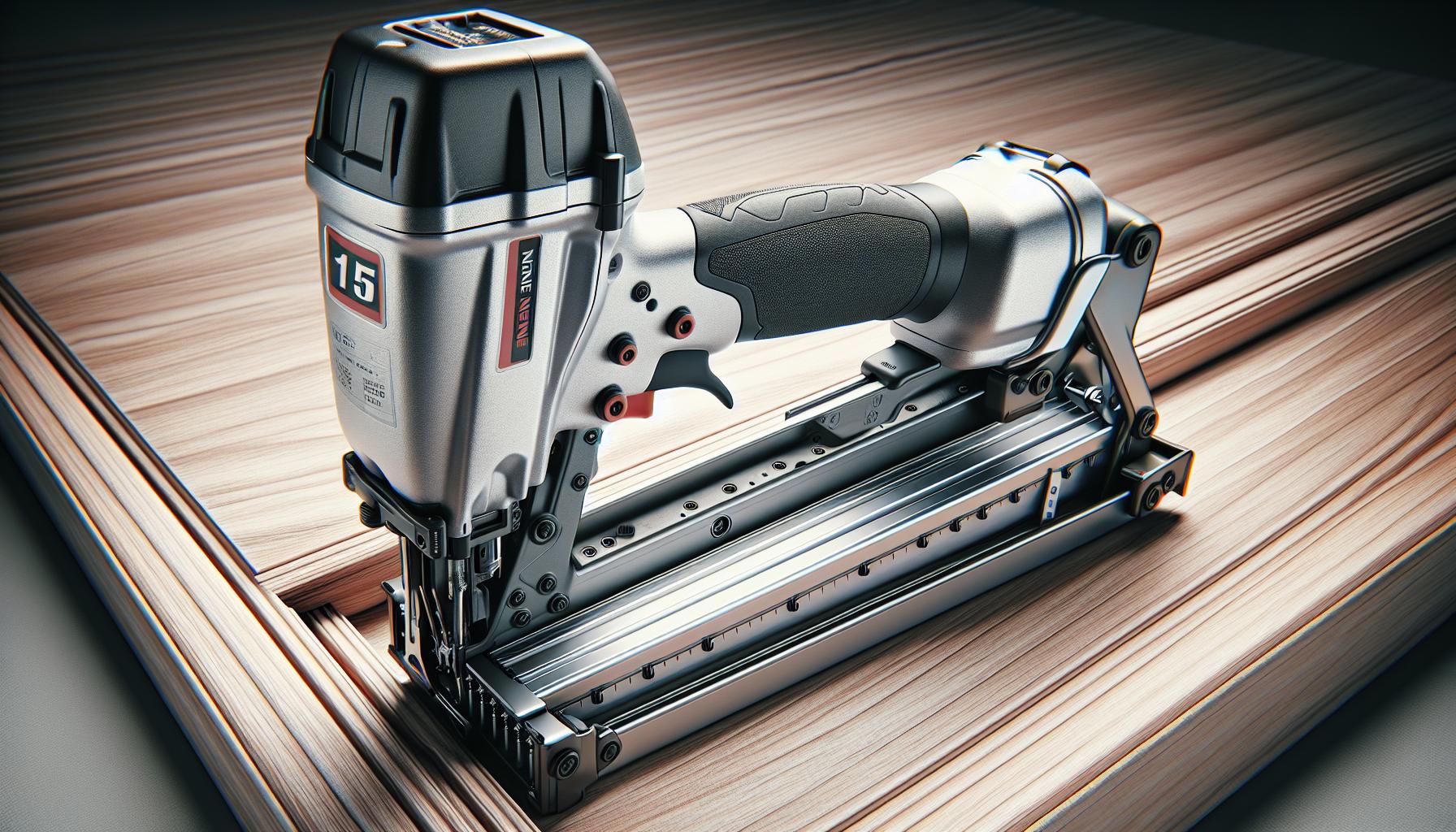When tackling a trim or finish carpentry project, choosing the right nailer is crucial for that flawless finish. I’ve used both the M18 16 gauge and 15 gauge finish nailers, and each has its unique strengths. Whether you’re a seasoned pro or a DIY enthusiast, understanding the nuances between these two powerhouses can make or break your work.
The 16 gauge nailer is a go-to for its versatility and is often favored for delicate trim work. On the other hand, the 15 gauge, with its thicker nails and angled design, offers a bit more holding power, ideal for heavier applications. I’ll dive into the specifics to help you decide which nailer best suits your project needs.
Choosing between the M18 16 gauge and 15 gauge finish nailers isn’t just about nail size—it’s about precision and the type of finish you’re aiming for. Stick with me, and I’ll guide you through the key differences, so you can nail your next project with confidence.
Key Differences Between M18 16 Gauge and 15 Gauge Finish Nailer
When it comes to the task at hand, selecting the right tool can make a significant difference. While both the M18 16 Gauge and 15 Gauge Finish Nailers are exceptional, their differences ensure that they cater to distinct needs in finish carpentry. Let’s delve into the specifics.
The 16 Gauge Nailer is leaner, making it the go-to choice for more refined projects. It uses thinner nails, which means smaller holes and less visible marks on your woodwork. This subtlety makes it an ideal tool for trim work where aesthetics are critical. Moreover, it’s lighter in weight, reducing user fatigue during prolonged use. The convenience of a 16 gauge nailer is unmatched when working on projects that require a delicate touch and precision.
On the other hand, the 15 Gauge Finish Nailer is the powerhouse among finish nailers. With a thicker diameter nail, it provides a robust hold that’s necessary for hanging doors or installing cabinets. These larger nails ensure a stronghold, and the added angle on many 15 gauge nailers allows for easier access to tight corners. Heavier and slightly more demanding in terms of handling, the 15 gauge is preferred for projects where structural integrity outweighs subtlety.
Here’s a quick reference:
| Feature | M18 16 Gauge Nailer | M18 15 Gauge Nailer |
|---|---|---|
| Nail Size | Thinner (less visible) | Thicker (more holding power) |
| Ideal Use | Trim and delicate installations | Structural work and heavy applications |
| Weight | Lighter (reduces fatigue) | Heavier (more robust) |
| Nail Visibility | Smaller holes (less filling required) | Larger holes (more robust hold) |
| Accessibility | Good for straightforward projects | Angled design for tight spaces |
My experience with these tools confirms that the 16 gauge nailer is superb for intricate detail work where the finish is paramount, and the 15 gauge nailer excels in projects demanding durability and strength. The choice between the two ultimately hinges on the specific needs of your project. Whether it’s the discreet placement of trim or the unyielding support for heavy installations, these nailers serve distinct purposes to ensure professional-level outcomes.
Benefits of Using a 16 Gauge Finish Nailer
When you’re tackling a task that demands precision, the 16 Gauge Finish Nailer is an exceptional tool. I’ve found that its slender nail size is its biggest asset when it comes to projects that involve delicate trim and molding. The nails are less likely to cause splitting or damage to the wood, which ensures a cleaner, more professional finish.
The design of the 16 Gauge Finish Nailer is tailored for ease of use and maneuverability. Its lightweight nature makes it easier to handle, particularly for overhead or extended use, reducing fatigue and allowing for more intricate work without the strain. This is particularly useful for intricate millwork, where finesse is more important than brute strength.
Moreover, the 16 Gauge Finish Nailer’s precision is not just about its size. It offers an excellent balance of hold and subtlety, making it the perfect companion for installing thinner trim and finer finishes. It’s the tool I reach for when I need to secure delicate pieces where a larger gauge nail might overpower and detract from the overall aesthetic.
Another advantage is that the thinner nails equate to smaller nail holes, which minimizes the need for wood filler and subsequent touch-up work. Consequently, it’s a time-saver, ensuring that the final stages of your project can be completed more swiftly.
For those concerned with aesthetics, the subtlety of the 16 Gauge Finish Nailer really can’t be beaten. When working on cabinetry, crown molding, or any other feature where appearance is a top priority, this tool ensures that the nails are almost invisible, preserving the sleek, seamless look of your project.
Here are the key benefits of using a 16 Gauge Finish Nailer:
- Less wood splitting, ensuring a clean finish
- Lightweight and manageable for intricate work
- Ideal balance between holding power and subtlety
- Smaller nail holes for minimal touch-up work
- Superior for aesthetically-sensitive projects
Given these benefits, I can vouch that the 16 Gauge Finish Nailer is a vital component in my toolkit for finer carpentry projects. Whether you’re a seasoned pro or an avid DIYer, this tool is bound to become a go-to for many jobs.
Advantages of Using a 15 Gauge Finish Nailer
When I’m tackling larger trim components, such as baseboards or staircases, a 15 Gauge Finish Nailer becomes my go-to tool. Its larger diameter nails provide a stronger hold, making it ideal for applying substantial trims that could potentially warp or come loose over time.
The 15 Gauge Nailer, with its angled magazine, allows me to reach into tighter corners with ease. This design is not just a matter of convenience; it’s a necessity for installing complex molding and trim work where space is limited.
Here are some key benefits:
- Increased holding power: The thicker nails ensure trims stay firmly in place.
- Durability: The nails used in 15 Gauge Nailers are more resistant to bending.
- Angled design: Provides better access in confined spaces.
In addition to its functional advantages, the 15 Gauge Finish Nailer supports a wider range of nail lengths. This versatility is critical for projects requiring different nail sizes, meaning I can seamlessly transition between tasks without changing tools.
Another significant aspect is the finishing it provides. Although the nail holes are slightly larger, they’re typically covered by the trim or can be easily filled and painted over, leaving a pristine finish. It’s a small trade-off for the robustness and stability that 15 Gauge Nails deliver.
Lastly, for projects that require exterior finishing or are exposed to varying weather conditions, the superior hold of the 15 Gauge Nails can be essential. It reduces the risk of future repairs or maintenance, which is an important consideration for long-term durability.
In short, when my projects need a little extra strength, 15 Gauge Finish Nailers have an edge. They ensure the job is done right with a hold that’s hard to match by thinner-gauge nailers. It’s just a matter of picking the right tool for the task at hand.
Factors to Consider When Choosing Between the M18 16 Gauge and 15 Gauge Finish Nailer
When deciding between the two nailer gauges, there are several key factors I keep in mind to ensure the best results for my projects.
Project Type
First and foremost, it’s important to assess the project I’m working on. 16 gauge finish nailers are my go-to for lighter trims, such as window casings or picture frames, where precision is more critical than hold strength. However, if I’m tackling larger installations like crown molding or robust chair rails, a 15 gauge finish nailer’s heft and power become a significant advantage.
Nail Size and Material
The size and material of the nails I plan to use also influence my choice of a nailer. The M18 16 gauge finish nailer accommodates thinner nails that are less likely to split delicate trim material.
Here’s a quick comparison of the two nail types:
| 16 Gauge Nails | 15 Gauge Nails |
|---|---|
| Thinner | Thicker |
| Less splitting risk | Stronger hold |
When dealing with harder woods or heavier material, the 15 gauge nails offer a larger diameter and therefore, more holding power, making them the superior option.
Maneuverability and Accessibility
Another aspect I consider is how accessible and maneuverable the nailer needs to be for the project. The M18 16 gauge nailer’s sleeker, straight design allows me to reach tighter spaces with ease, while the angled construction of the 15 gauge nailer grants accessibility at awkward angles, especially in corners or where the trim meets at an incline.
Finish and Aesthetics
The final appearance matters as well. The smaller head of 16 gauge nails leaves behind a less noticeable mark, preserving the smooth finish of the workpiece. This is critical when I’m aiming for a flawless, professional-grade finish where nail heads need to be unobtrusive or near invisible.
Durability Over Time
Lastly, the durability of the completed work plays a major role in my decision-making process. For pieces that may face environmental stressors or high traffic, the stronger 15 gauge nails provide the assurance that my work will stand the test of time.
Considerations for Delicate Trim Work
When tackling delicate trim work, it’s crucial to choose the right tool that complements the intricacy and finesse required. I’ve found that precision is key, and this is where an M18 16 Gauge Finish Nailer often excels. Its slender, lighter nails are less prone to splitting fine moldings, therefore preserving the integrity of the wood. This becomes particularly important when working with softwoods or pre-finished trims, which can be easily damaged by larger, more intrusive nails.
The size of the nail head is another vital aspect; the 16 gauge nailer typically uses smaller heads, which are less visible once set and filled. This contributes to a cleaner, more subtle finish, a must for projects where aesthetics are paramount.
Ease of handling should also be part of the decision process. The M18 16 Gauge Nailer’s lightweight design affords me greater control during intricate work, thereby reducing fatigue and allowing for longer periods of uninterrupted precision work. I’ve also noticed that its balance and ergonomics aid in achieving a consistent nail placement, which is a game-changer for delicate trim.
The nail length variety in a 16 gauge finish nailer is more suited for the less demanding nature of delicate trim. I can easily switch between nail sizes depending on the project’s requirements and avoid overkill, which is often a risk with more robust nailers.
An often overlook detail is the noise level. High-pressure equipment can be startling, potentially leading to accidental movement and thus, imprecision. I appreciate that the M18 16 Gauge Nailer operates relatively quietly, keeping the disruption to a minimum.
Maneuverability within tight spaces deserves attention as well. When there’s little room for movement, a compact tool such as the M18 16 Gauge Finish Nailer is my go-to, turning an awkward angle into an achievable stroke.
- Smaller, less intrusive nails prevent trim damage
- Smaller nail heads for a cleaner finish
- Lightweight and ergonomic for control and less fatigue
- Variety of nail lengths suited to delicate work
- Quieter operation to minimize disruptions
- Compact design for tight space maneuverability
Considering these points, it’s clear that when delicate trim and attention to detail are at the forefront, the M18 16 Gauge Finish Nailer holds its own against its formidable counterpart, the 15 Gauge.
Importance of Holding Power for Heavier Applications
When tackling heavier trim and carpentry jobs, the importance of holding power cannot be overstated. 15 gauge finish nailers offer superior holding power compared to their 16 gauge counterparts. This is largely due to the larger diameter nails they use, which provide a stronger hold that’s essential for weightier materials and high-traffic areas where trim elements must endure more stress.
An M18 15 gauge finish nailer can drive thicker nails, typically ranging in size from 1 1/4″ to 2 1/2″. The increased thickness ensures a more robust and secure installation, perfect for tasks such as hanging doors or installing heavy crown moldings. The added holding power of 15 gauge nails makes them particularly well-suited for these applications where the additional grip can mean the difference between a job well done and a repair call.
Another point to consider is the angle of the nailer. Unlike the straight design typically found in 16 gauge nailers, 15 gauge finish nailers often come with an angled magazine. This design allows you to reach into tighter corners and provides a clear line of sight for precise nail placement. The nails used in a 15 gauge nailer also frequently feature a DA style head, which is more pronounced and thus more capable of resisting the forces of gravity and lateral pressure.
For anyone prioritizing longevity and durability in their trim and heavier application jobs, a 15 gauge option should be a go-to tool. I’ve used it in residential and commercial settings alike, and the results are consistently reliable— the heavy-duty nails ensure that materials stay put long after the installation is complete.
While the 16 gauge finish nailer excels in the realm of delicate trim work, the 15 gauge steps up when heft and hold become paramount on larger-scale projects or in areas requiring additional strength. The trade-off for its power is a larger nail hole, but for many applications, that’s a minor compromise for the benefits gained.
Conclusion
Choosing the right finish nailer boils down to the specifics of your project. I’ve found that the M18 16 Gauge Finish Nailer excels in precision tasks where a clean, subtle finish is paramount. It’s my go-to for softwoods and delicate trims, ensuring that the final look is flawless without the risk of splitting. Its lightweight and quiet operation are real bonuses for intricate, finesse work. On the flip side, when I’m tackling larger projects or installing trim in high-traffic areas, the 15 gauge finish nailer’s robust holding power is indispensable. Its angled magazine and clear line of sight make it a powerhouse for secure, lasting installations. So whether you’re adding the finishing touches to a custom piece or beefing up the durability of your carpentry, there’s a nailer that fits the bill. Choose wisely, and your work will stand the test of time.
Frequently Asked Questions
What is the main benefit of using a 16 Gauge Finish Nailer for trim and molding projects?
A 16 Gauge Finish Nailer is less likely to split fine moldings and is perfect for working with softwoods or pre-finished trims, offering a clean and subtle finish.
Why is a 16 gauge nailer recommended for delicate trim work?
The smaller nail heads of a 16 gauge nailer provide a precise and less noticeable finish. Also, its lightweight design enhances control and reduces fatigue in intricate work.
Can I use 16 gauge nails with heavy trim or carpentry jobs?
No, for heavier trim and carpentry jobs, a 15 gauge finish nailer with larger diameter nails is recommended for superior holding power, especially in high-traffic areas.
Are there any advantages to the design of a 16 gauge nailer?
Yes, 16 gauge nailers are often lighter and offer better maneuverability in tight spaces due to a more compact design, and they typically operate more quietly than larger nailers.
When should I use a 15 gauge finish nailer instead of a 16 gauge?
You should use a 15 gauge finish nailer for larger-scale projects that require additional strength. These nailers provide a secure installation and often feature an angled magazine for precise nail placement in tight areas.



Reader Interactions